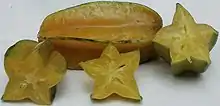Caramboxine
La caramboxine (CBX) est un composé organique de la famille des acides aminés aromatiques. C'est une toxine présente dans la carambole (Averrhoa carambola)[2] - [3]. Elle est plus particulièrement dangereuse pour les personnes souffrant d'insuffisance rénale chronique qui risquent des effets neurologiques, intoxication, crise d'épilepsie, voire la mort en cas d'ingestion du fruit[4]. La caramboxine est acide aminé non protéinogène qui stimule les récepteurs de glutamates (en) dans les neurones. Sa structure chimique est assez similaire à celle de la phénylalanine. La caramboxine est un agoniste des récepteurs inotropes glutamatergiques NMDA et AMPA, avec de puissantes propriétés excitatrices, convulsives et neurodégénératives[5].
| Caramboxine | |

| |
| Identification | |
|---|---|
| Nom systématique | acide 2-[(2S)-2-amino-2-carboxyéthyl]-6-hydroxy-4-méthoxybenzoïque |
| No CAS | |
| PubChem | 134728497 |
| SMILES | |
| InChI | |
| Propriétés chimiques | |
| Formule | C11H13NO6 [Isomères] |
| Masse molaire[1] | 255,224 ± 0,011 7 g/mol C 51,77 %, H 5,13 %, N 5,49 %, O 37,61 %, |
| Unités du SI et CNTP, sauf indication contraire. | |
Du fait des risques d'empoisonnement à la caraboxine, pouvant mener à une insuffisance rénale aiguë, il est déconseillé de manger le fruit ou de boire son jus à jeun[6].

Notes et références
- (en) Cet article est partiellement ou en totalité issu de l’article de Wikipédia en anglais intitulé « Caramboxin » (voir la liste des auteurs).
- Masse molaire calculée d’après « Atomic weights of the elements 2007 », sur www.chem.qmul.ac.uk.
- (en) Sarah Everts, « Star fruit’s chemical curse », Chemical & Engineering News, vol. 91, no 48, , p. 28 (OCLC 567617114)
- Norberto Garcia-Cairasco, Miguel Moyses-Neto, Flavio Del Vecchio, José A. C Oliveira, Francisco L Dos Santos, Olagide W Castro, Gabriel M Arisi, Márcio Dantas, Ruither O. G Carolino, Joaquim Coutinho-Netto, Andre L. A Dagostin, Marcelo C. A Rodrigues, Ricardo M Leão, Samir A. P Quintiliano, Luiz F Silva, Leonardo Gobbo-Neto et Norberto P Lopes, « Elucidating the Neurotoxicity of the Star Fruit », Angewandte Chemie International Edition, vol. 52, no 49, , p. 13067 (PMID 24281890, DOI 10.1002/anie.201305382)
- Camille Pereira Caetano, Cinara Barros De Sá, Bruno Antônio Paixão Faleiros, Marcelo Fonseca Coutinho Fernandes Gomes et Edna Regina Silva Pereira, « Neurotoxicity following the Ingestion of Bilimbi Fruit (Averrhoa bilimbi) in an End-Stage Renal Disease Patient on Hemodialysis », Case Reports in Nephrology and Dialysis, vol. 7, no 1, , p. 6–12 (PMID 28203564, PMCID 5301110, DOI 10.1159/000454945)
- N. Garcia-Cairasco, M. Moyses-Neto, F. Del Vecchio, J. A. C. Oliveira, F. L. Dos Santos, O. W. Castro, G. M. Arisi, M. R. Dantas, R. O. G. Carolino, J. Coutinho-Netto, A. L. A. Dagostin, M. C. A. Rodrigues, R. M. Leão, S. A. P. Quintiliano, L. F. Silva, L. Gobbo-Neto et N. P. Lopes, « Elucidating the Neurotoxicity of the Star Fruit », Angewandte Chemie International Edition, vol. 52, no 49, , p. 13067 (PMID 24281890, DOI 10.1002/anie.201305382)
- Neto, G. E Silva, R. S Costa, O. M Vieira Neto, N Garcia-Cairasco, N. P Lopes, P. F Haendchen, C Silveira, A. R Mendes, R. R Filho et M Dantas, « Star fruit: Simultaneous neurotoxic and nephrotoxic effects in people with previously normal renal function », Clinical Kidney Journal, vol. 2, no 6, , p. 485–488 (PMCID 4421323, DOI 10.1093/ndtplus/sfp108)